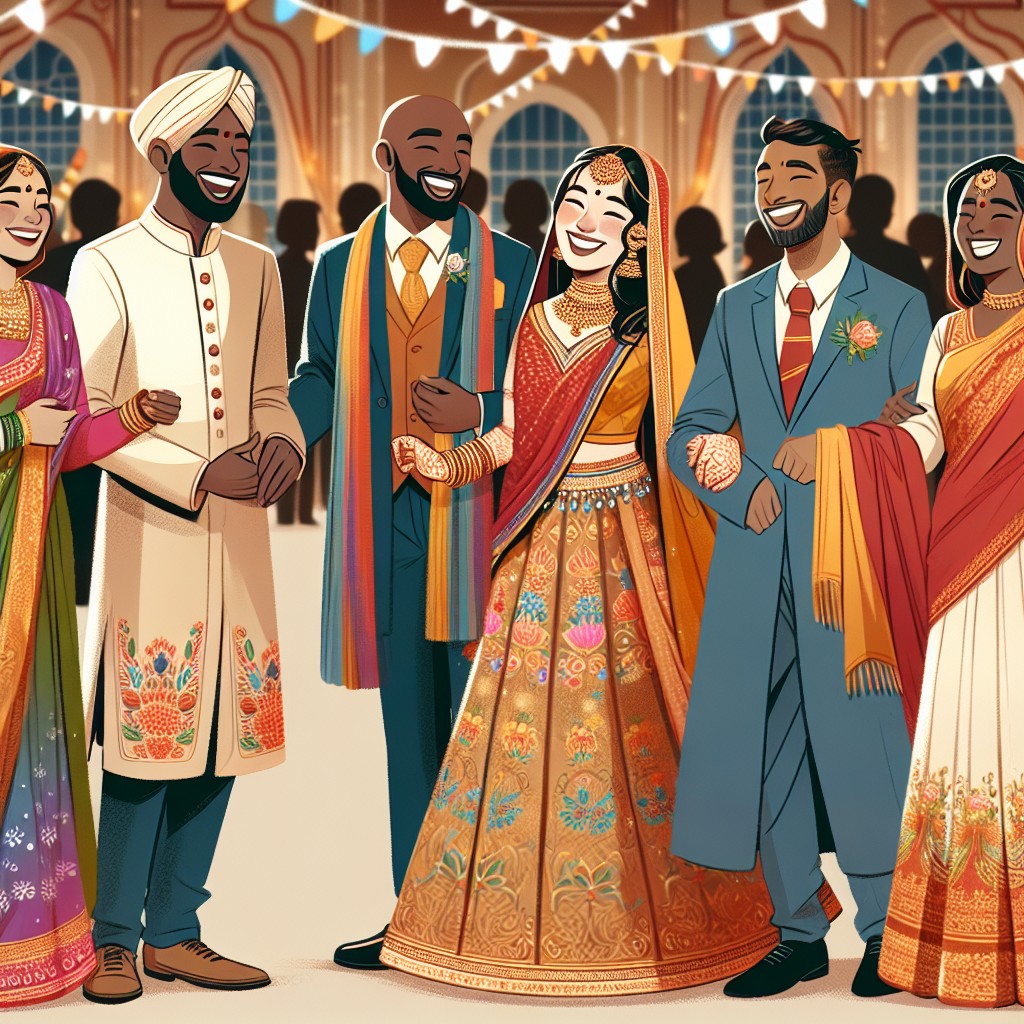Discover appropriate attire choices for guests attending an Indian wedding to ensure respect for cultural traditions and etiquette.
Key takeaways:
- Opt for vibrant hues and gold/silver accents.
- Dress modestly and respect customs.
- Different ceremonies have different dress codes.
- Choose between kurta, sherwani, or Western suit for men.
- Saree, lehenga, or anarkali for women.
Color Palette Considerations for Indian Weddings

When attending an Indian wedding, your color choice plays a significant role in aligning with the festive atmosphere. Vibrant hues mirror the event’s exuberance. Opt for rich, saturated colors like maroon, royal blue, emerald green, and bright pinks. Gold and silver accents are always a hit, adding a touch of glamour to your outfit.
On the contrary, it’s wise to steer clear of white and black as they are traditionally associated with mourning, and red should be avoided as it is often reserved for the bride. Light pastels are less common but can be suitable for daytime events, as long as they’re cheerful and lively. No matter what color you choose, ensure it reflects the joy and the lively spirit of the celebration.
Adhering to Cultural Sensitivity and Tradition
Understanding and respecting the customs of an Indian wedding is vital. Here are some points to keep in mind:
- Dress modestly, covering shoulders and knees, out of respect for religious and cultural practices.
- Avoid white or black as they symbolize mourning and avoid red, which is often reserved for the bride.
- Traditional attire is highly encouraged; it’s an opportunity to celebrate Indian culture’s vibrant fabrics and intricate designs.
- If the invitation specifies a regional attire, like Punjabi or Gujarati, it’s considerate to follow the suggestion or opt for general traditional wear.
- Inquire with the hosts if you’re uncertain about clothing choices; they’ll appreciate the gesture and provide guidance.
Dress Codes for Specific Ceremonies
Indian weddings often span multiple days, with each ceremony boasting its own ambiance and expected attire.
Mehndi Ceremony: Bright, vibrant colors echo the joyfulness of this event. Opt for light and comfortable clothing like a colorful kurta or a flowing Anarkali.
Sangeet: This musical evening is your chance to shine. Embellished attire is encouraged—men can choose a Sherwani, while women might wear a sparkling Lehenga.
Haldi: For the turmeric-smearing ceremony, wear clothes that can handle staining. Yellow and orange hues are traditional, reflecting the colors of turmeric.
Wedding Ceremony: Elegance takes the forefront—silks and velvets with intricate embroidery are appropriate. Men often wear a Sherwani or a Western suit, while women might select a heavily embroidered Saree or Lehenga.
Reception: It’s time for glitz and glam. Darker colors and sophisticated styles are typical, with men donning tuxedos or formal Sherwanis and women in elegant sarees or Indo-Western gowns.
Remember, the key is to respect the significance of each event while ensuring your attire aligns with the time of day and level of formality.
Choosing the Right Men’s Attire: Kurta, Sherwani, Western Suit
Selecting appropriate attire for men attending an Indian wedding involves understanding the nuances of the event’s formality and cultural expectations. Here’s a quick guide to help you decipher which option could be the most suited for the occasion:
- Kurta: A versatile choice, kurtas are long tunics paired with churidar pants or dhotis. For a more casual function like a Mehndi or Sangeet, opt for lighter fabrics and simpler designs. Silk or embroidered kurtas are more suitable for the wedding day or reception.
- Sherwani: A sherwani is a long coat-like garment that is elegantly detailed with embroidery, and it often comes with a matching bottom. It’s typically reserved for the wedding ceremony and receptions due to its formal and regal appearance. Pair it with traditional footwear like juttis or mojaris to complete the look.
- Western Suit: If the invitation indicates a Western dress code, or the event is less traditional, a smart suit is acceptable. Stick with darker colors or neutrals, and consider adding a touch of Indian flair with a vibrant tie or pocket square to honor the cultural setting.
Remember, whatever you choose, ensure it’s comfortable, fits well, and aligns with the wedding’s level of formality.
Navigating Styled Outfits for Women: Saree, Lehenga, Anarkali
When choosing your ensemble as a female guest, understanding the significance and styling of traditional outfits can elevate your experience. Sarees, a timeless garment, offer elegance with their draped fabric and can be selected in a variety of materials from silk to cotton, depending on the formality of the event. Ensure it’s draped neatly for a polished look.
Lehengas are a popular choice for their comfort and grandeur, featuring a long, embellished skirt, a cropped top known as a ‘choli’, and a matching ‘dupatta’ (shawl). They come in different styles and fittings, making them suitable for various body types.
For those preferring a flowing silhouette, an Anarkali suit is an apt pick. This outfit is comprised of a long frock-style top and slim-fitting bottoms, with its flared shape offering mobility and a regal feel.
When selecting any of these outfits, opt for vibrant colors and traditional embroideries to align with the celebratory nature of Indian weddings. However, avoid wearing red as it is often reserved for the bride. Lastly, complete your look with complementary jewelry and a pair of comfortable, yet stylish, footwear.



